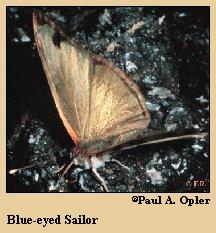 |
 

 |



Blue-eyed Sailor (Dynamine dyonis Geyer)
Wing span: 1 5/8 - 1 7/8 inches (4.1 - 4.8 cm).
Identification: Upperside of male is copper-green; female is black with white bands and patches. Underside of both sexes with 2 round, blue submarginal spots.
Life history: Eggs are laid singly on the leaves and stems of the host plant. Caterpillars eat leaves and rest underneath them.
Flight: May-November in Texas, March-November in Mexico.
Caterpillar hosts: Noseburn (Tragia neptifolia) and Dalechampia, both in the spurge family (Euphorbiaceae).
Adult food: Nectar from various composite flowers.
Habitat: Tropical forest edges.
Range: Colombia north through Central America to central Mexico. Periodic stray and occasional resident to north-central Texas.
Conservation: Not required for periodic stray and occasional resident.
The Nature Conservancy Global Rank: G5 - Demonstrably secure globally, though it may be quite rare in parts of its range, especially at the periphery.
Management needs: None reported.
References:
DeVries, P. J. 1987. The butterflies of Costa Rica and their natural history.
Papilionidae, Pieridae, Nymphalidae. Princeton University Press, Princeton,
New Jersey. 327 pages, 50 color plates.
Opler, P. A. and V. Malikul. 1992. A field guide to eastern butterflies. Peterson
field guide #4. Houghton-Mifflin Co., Boston. 396 pages, 48 color plates.
Scott, J. A. 1986. The butterflies of North America. Stanford University Press,
Stanford, Calif. 583 pages, 64 color plates.
Author: Jane M. Struttmann

